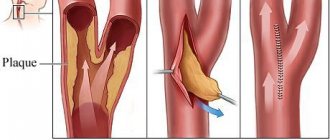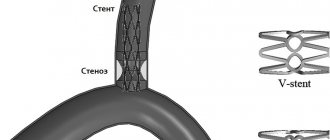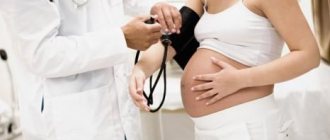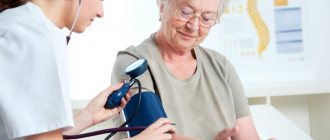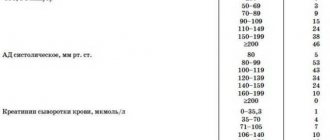Stroke is an acute disease that is accompanied by the death of brain cells due to acute cerebrovascular accident. It manifests itself with general cerebral and local symptoms. The development of a stroke is possible in two scenarios: either after 24 hours from the onset of the disease, its symptoms persist, or death occurs.
Diagnostic examination for developing stroke includes:
- clarification of complaints and history of the disease;
- neurological examination;
- blood tests (determining the level of enzymes and blood glucose, the state of the coagulation and anticoagulation systems).
- Dopplerography - study of blood flow in the vessels of the neck and brain;
- computed tomography helps distinguish between ischemic and hemorrhagic strokes;
- Magnetic resonance imaging is more informative in cases of developing stroke;
- magnetic resonance angiography and computed tomography angiography are non-invasive methods for assessing the carotid and cerebral arteries;
- an electrocardiogram allows you to assess the condition of the heart muscle;
- Echocardiography (EchoCG) is a research method with which doctors at the Yusupov Hospital identify blood clots in the cavities of the heart, which allows them to assess the risk of developing a recurrent stroke.
Make an appointment
Types of brain strokes
The most common ischemic stroke (infarction) of the brain - 85% of cases, hemorrhagic stroke occurs in 15% of cases. Strokes can be caused by several reasons:
- formation of thromboembolism in heart diseases;
- acute circulatory disorders in the cervical and large cerebral arteries;
- disturbance of blood circulation in the small arteries of the brain during the acute course of the process.
Classification of strokes
Strokes are classified according to the causes of circulatory disorders and the duration of neurological symptoms. At the Yusupov Hospital, the patient will undergo a diagnostic examination, which will allow the type of stroke and the area of brain damage to be very quickly and accurately determined. When a patient is admitted to the clinic, a number of studies are carried out as prescribed by the doctor:
- MRI – magnetic resonance imaging;
- CT – computed tomography;
- Doppler ultrasound;
- cerebral angiography.
Classification of ischemic stroke (infarction) of the brain:
- hemorheological blockage of cerebral vessels. This condition develops with increased blood clotting and platelet aggregation;
- embolic stroke. Occurs in 20% of cases of ischemic stroke, develops when an artery is blocked by emboli (intravascular substrates) that enter small vessels from larger blood vessels;
- atherothrombotic stroke. Found in 50% of patients with ischemic stroke. A blood clot forms at the site of the atherosclerotic plaque, leading to blockage of the vessel;
- lacunar stroke. Arterial hypertension leads to the development of atherosclerosis, which causes narrowing of small arteries and reduced blood flow to areas of the brain. Occurs in 25% of cases;
- hemodynamic stroke. The pathological condition is caused by a sharp narrowing of a large vessel in the brain due to a drop in blood pressure during heart failure. Blood flow to a part of the brain stops, and an ischemic stroke develops.
Classification of hemorrhagic strokes:
- an outpouring of blood when a vessel ruptures in the brain tissue - parenchymal hemorrhage;
- formation of hematoma in the ventricles of the brain - intraventricular hemorrhage;
- hemorrhage into the cavity between the pia mater and the arachnoid membrane is called subarachnoid;
- Epidural, subdural and mixed forms of hemorrhages are quite rare.
Classification according to the duration of neurological symptoms:
- minor stroke – symptoms manifest from one day to three weeks. Recovery from one day to three weeks;
- transient ischemic attack - symptoms last for about a day, recovery within a day;
- Completed ischemic stroke – symptoms of the disease have been observed for more than three weeks, recovery does not occur for more than three weeks.
Selected most critical time periods
Doctors have developed some statistics that have made it possible to determine certain periods of time that are most dangerous to the life of a patient who has suffered a stroke. The most dangerous period is the first two days after the onset of a cerebral catastrophe.
Also, the risk increases significantly on days 7-10 and 14-21 after the pathology has occurred. The percentage statistics for deaths are as follows:
- 1st day – 45.9%;
- 7th day – 24.5%
- 14th day – 17.3%
- 21st day – 12.2%.
That is why back in the 60-70s. The World Health Organization has identified a 21-day period as the most critical period for the life of a person who has suffered a stroke. After active recovery and properly prescribed therapy, the situation begins to improve and the person gets better.
Periods of stroke
Among the huge number of neurological diseases, stroke is the most important problem. Hemorrhage in the brain leads to disruption of intracranial circulation, neuronal necrosis and disruption of vital body functions.
In ischemic stroke, a number of processes are observed that together lead to the death of neurons. Cell destruction occurs against the background of cerebral edema. At the same time, the brain increases in volume and intracranial pressure increases.
Due to cell swelling, displacement of the temporal lobe is observed, as well as infringement of the midbrain.
Compression of the medulla oblongata may also occur due to wedging of the cerebellar tonsils into the foramen magnum. This process quite often leads to death. Therefore, early hospitalization of the patient is extremely important.
When the first signs of an ischemic stroke appear, medical assistance should be provided within the first three hours, otherwise the prognosis is disappointing.
There are several periods of ischemic stroke:
- acute;
- spicy;
- early recovery period of stroke;
- late recovery;
- stage of residual effects.
The most acute period
In the first three hours, it is possible to restore blood flow and eliminate or reduce neuronal death through the use of thrombolytics. It is also possible to administer drugs into the stroke area itself, which helps prevent the development of complications.
Then doctors take measures to restore pressure, carry out rehydration, dehydration and oxygen therapy.
During the most acute period of a stroke (from 4 to 5 hours after the attack), the patient should be under the close supervision of a doctor in a hospital setting.
Acute period
The period up to 14 days after the attack is considered acute. The patient continues to undergo treatment in a specialized department of the hospital. He is undergoing drug therapy aimed at:
- reduction of cerebral edema;
- maintaining normal blood viscosity and coagulability;
- maintaining normal functioning of the cardiovascular system;
- relapse prevention;
- maintaining normal blood pressure.
Early recovery period
The early recovery period is considered to be the period from 2 to 6 months after a stroke. At this stage, complex treatment is carried out:
- the patient takes medications according to an individual treatment regimen;
- in case of speech impairment, a speech therapist works with the patient;
- various manipulations are prescribed to restore sensitivity of the limbs and other parts of the body (massages, baths, acupuncture and others);
- physical therapy – the method helps strengthen ligaments and muscles.
Late recovery period
The late recovery period is the time six months after the stroke. At this stage, the results of treatment and rehabilitation measures taken during the early recovery period are already visible.
The patient's finger sensitivity is restored and motor skills improve. It is extremely important not to stop the complex of procedures. Rehabilitation after a stroke is a long and labor-intensive process.
Period of residual effects
The time from one to two years after a stroke is considered the residual period. At this stage, it is important to follow all doctor’s instructions and take measures to prevent a recurrent stroke.
Rehabilitation specialists and neurologists at the Yusupov Hospital create a treatment and rehabilitation program individually for each patient, which allows achieving high results in recovery after a stroke.
Expert opinion
Author: Vladimir Vladimirovich Zakharov
Neurologist, Doctor of Medical Sciences, Professor, Head of the Center for Diagnostics and Treatment of Memory Disorders
According to statistics provided by WHO, stroke ranks third in prevalence among all neurological diseases. Doctors note an annual increase in incidence. In Russia, 400 thousand new cases of stroke are registered every year. More than 30% of them are fatal. Acute cerebrovascular accident is not a disease characteristic of older people. The disease can be diagnosed in 5-year-old children. A distinctive feature of old age is considered to be a greater number of factors predisposing to the development of stroke.
At the Yusupov Hospital, diagnosis of cerebrovascular accidents is carried out using modern medical equipment. CT and MRI make it possible to assess the size of the pathological lesion, its location, and the type of stroke. Treatment is developed individually for each patient. The drugs used meet quality and safety standards. If necessary, surgical intervention is performed. During the rehabilitation period, each patient is prescribed a course of physiotherapy and a complex of physical therapy. Experienced massage therapists work the muscles, helping to restore lost functions.
Recovery time after hemorrhagic stroke
The rehabilitation performed after such a brain injury consists of several stages:
- early period, lasting about six months after the attack;
- later recovery, lasting from six months to 1 year;
- the stage of final recovery, which in its duration occupies the entire subsequent time.
A year after the attack, residual effects begin. The best results during rehabilitation can be obtained in the first year; for this reason, recovery should not be delayed.
Effective results are obtained by strictly observing the following important principles:
- taking action at an early stage of ongoing treatment in a hospital;
- daily implementation by the patient of appropriate recommendations without any delays;
- prescribing special physical activity with appropriate intensity and gradual complication of exercises.
In addition, it is very important to take comprehensive measures: prescribing physiotherapy, drug treatment and the necessary correction of the patient’s psychological state. During this period, a recovering person must protect himself from unnecessary stressful situations, and also be surrounded by the care and love of family and friends.
Causes and consequences of stroke
The following causes of stroke are known:
- age. People at risk for stroke include older people, especially those who have high blood pressure, lead a sedentary lifestyle, are overweight, or smoke or drink heavily. Currently, stroke is increasingly developing in young people;
- floor. In most age groups, stroke is more common in men than in women. However, it is more severe and more often fatal in women. This is due to the use of contraceptives, hormonal imbalance and emotional imbalance in women;
- family history. In most cases, the closest relatives of patients suffering from stroke have suffered acute cerebrovascular accident;
- smoking. Individuals who smoke more than 20 cigarettes per day have a 2-fold increased risk of stroke;
- nutrition. The predominance of saturated fats, light carbohydrates and excess amounts of table salt in the diet contributes to an increase in blood pressure, which is the main factor in hemorrhagic stroke;
- insufficient physical activity. Lack of regular exercise increases the risk of obesity and increases poor circulation, which contributes to the development of stroke.
- drug use. Drugs, especially methamphetamine and cocaine, are a major factor in the development of stroke in young people. Anabolic steroids, which athletes often take, also increase the likelihood of stroke.
- diseases of the heart and blood vessels. People suffering from diseases of the cardiovascular system, especially those accompanied by cardiac arrhythmias, and peripheral vascular pathology are at increased risk of developing stroke;
- a stroke increases the risk of acute cerebrovascular accident by 10 times;
- Arterial hypertension is the cause of 70% of strokes. Patients with hypertension have a 10 times higher risk of stroke than people with normal blood pressure.
- high cholesterol levels increase the risk of developing atherosclerosis of the cerebral arteries and impaired blood flow through the cerebral vessels;
- Coronary heart disease increases the risk of stroke. Anti-clotting drugs, which are used to treat cardiovascular diseases, dissolve blood clots but also increase the risk of hemorrhagic stroke.
- Atrial fibrillation is a major risk factor for stroke associated with heart rhythm disturbances. 2-4% of patients with atrial fibrillation without warning signs of cerebral bleeding develop a stroke.
The consequences of a stroke are impaired motor, speech, visual, cognitive function, and sensitivity disorders. They are prevented at the Yusupov Hospital by a team of specialists, which includes neurologists, cardiologists, speech therapists, psychotherapists, and rehabilitation specialists.
Seizures after stroke
Some consequences of a stroke can be treated and restored with adequate medical care. These consequences include seizures that occur in women and men after an ischemic or hemorrhagic stroke.
The development of convulsive syndrome is caused by the death of brain neurons and the formation of a focus of necrosis. The body's response to this process is the activation of other neurons to restore blood circulation and stop the pathological process. Necrotic tissue is replaced by a cavity filled with fluid; when a cyst forms, a person does not feel discomfort. However, when neurons are irritated by the cyst, seizures can occur.
After a stroke, seizures can manifest in patients in the form of:
- numbness of one or both limbs at the same time, feeling of a wooden leg or arm;
- contractions of the muscles of the face and neck, resulting in a “mask-like face”, tilting of the head to one side or asymmetry of the face on one side;
- contractions of the facial muscles against the background of numbness of the limbs.
Some patients experience mild tremors after a stroke, while other patients experience short-term cramps throughout the body.
Why does a stroke occur?
WHO experts believe that in the 21st century, stroke will become the most common disease. An increase in the pace and intensity of life, water and air pollution, exposure to occupational factors, alcohol consumption and smoking, excess caloric content and insufficient quality nutrition, a sedentary lifestyle, poor heredity - this is quite enough, but there are other reasons, the main one of which is population aging. An increase in stroke cases in the population of older age groups could explain everything, but...
- Over the past 5 years, a third of the total number of patients with cerebrovascular accidents were people under the age of 50;
- Arterial hypertension in adolescents is detected 3 times more often;
- From 1990 to 2000 in Russia, the absolute number of people dying annually from diseases of the circulatory system increased by 307,000
All these data indicate that stroke is getting younger.
Temperature after stroke
Temperature during a stroke is an indicator of cerebral hemorrhage, hemorrhagic stroke. With an ischemic stroke, the temperature in most cases is slightly lowered; with a hemorrhagic stroke, the temperature rises.
Timely medical care reduces the risk of developing severe complications. After a stroke, it is difficult to deal with high fever - antipyretics can aggravate the condition of a patient with a hemorrhagic stroke, and in the case of an ischemic stroke cause hemorrhagic transformation.
Temperature after stroke: causes and treatment
Temperature during a stroke is a very important indicator of the patient’s condition. It is most often used to determine the degree of brain damage in a patient. Temperature readings up to 38 degrees are considered to be the maximum permissible.
Stroke studies have shown that the majority of stroke patients had a normal mean temperature upon admission to the clinic. In patients with extensive strokes, the temperature began to rise after a few hours (4-6) to 40 degrees. In patients with moderate strokes, the temperature rose to 40 degrees 12 hours after the stroke. A mild stroke most often occurs without fever or with a slight rise in temperature.
Complications after a stroke
After a stroke, fever often occurs due to the following complications:
- the damage occurred over a large area of the brain;
- swelling of brain tissue has developed;
- during a stroke, the thermoregulation center in the brain was damaged;
- complication after a stroke – pneumonia;
- an allergic reaction to medications developed.
In cases where the cause of the increase in temperature is its central genesis, doctors perform craniocerebral hypothermia. The brain is cooled through the outer covering of the head using special equipment. This method increases the brain's resistance to oxygen starvation, reduces the risk of developing cerebral edema, relieves existing edema, and reduces tissue temperature.
Types of rehabilitation after hemorrhagic stroke
The necessary medicinal and motor rehabilitation is carried out for the following purposes:
- significant reduction in the risk of recurrence of hemorrhagic stroke;
- gradual return to normal lifestyle;
- return of lost ability to work;
- the patient performs basic skills and actions;
- preserving the patient’s identity through the provision of social and psychological assistance.
Drug treatment
In the human brain, dead neurons are replaced with elements with high activity. But due to the increasing load, additional energy is necessarily required. Neurons that remain alive after damage restore lost functions over time.
Prescribed medications provide additional nutrition and significantly improve recovery processes in the brain. Additional courses of essential drug therapy are recommended once every three months throughout the year.
Drugs that are administered to the patient by injection during treatment:
- nootropics, which include piracetam, Actovegin and other drugs;
- medications to stimulate the necessary impulses in brain cells, for example, proserin or neuromidin;
- selected B vitamins that improve cell metabolism.
Taking the prescribed medications should continue even after completion of the prescribed treatment in the hospital. At home, tablets are taken with food.
Chronically high blood pressure is corrected with medication. If necessary, the doctor prescribes suitable medications for blood pressure, calcium channel blockers in vascular cells, or drugs to lower blood sugar levels.
Motor recovery
It is necessary to restore lost movement already at the stage of inpatient treatment after primary care has been provided. It is imperative to provide physical activity to the limbs to improve blood circulation, which helps in reducing tone and prevents the appearance of congestion in the blood vessels, and also protects the patient from the occurrence of pneumonia due to a recumbent lifestyle.
The position of the limbs in a supine state, if necessary, is corrected using a splint or special weights. Such patients must turn over every 2 hours to prevent the appearance of bedsores on the skin; in addition, this is recommended to stabilize blood pressure.
A few days after the attack, passive gymnastics begins, during which the person is assisted in smooth movement of various parts of the body. Procedures are carried out only if the person does not experience pain. If the condition improves, you should help the patient learn to take a sitting position, and then help him restore an upright position. Before walking, leg training is performed in order to regain the lost sense of position in space. Then the patient needs to begin to move around using supports, walkers and canes.
Movement restoration techniques
Physical therapy plays a significant role in the rehabilitation of lost motor ability. In this case, suitable exercises are developed for different muscle groups, classes are conducted using special simulators, and a device is used to reduce high muscle tone.
Prescribing a special massage is very useful. First, the limbs are stroked with a sufficiently high muscle tone, and then other muscle groups are rubbed. The use of a warm heating pad before the session significantly improves the effect. The massage procedure can take 20 minutes and mainly depends on the current condition of the patient.
Effective methods of physiotherapy include oxygen baths, electrophoresis of blood vessels in the neck, and electrical stimulation of muscles that have lost their functions as a result of a stroke.
Speech restoration
The return of speech is possible even after an attack that occurred more than a year ago. Conversation after a stroke should be slow and words pronounced clearly. At the same time, there is no need to rush to answer and ask difficult questions.
Working with a speech therapist helps a lot in restoring muscle functionality. Practicing in front of a mirror can also be very useful. In the process of noticeable improvements, it is possible to complicate tasks and stimulate a person to pronounce more complex spoken phrases.
Restoring breathing and swallowing
Nutrition of patients in a hospital is most often performed using a special feeding tube. Then comes the time to independently master the skill of eating food. Proper preparation of foods greatly simplifies the rehabilitation of a patient seriously affected by a stroke. Cooked food should be warm, not hard and have a soft texture. Flavorful foods trigger saliva production.
Patients should absolutely not be rushed during the process of eating; this process can take half an hour or more. You may need help holding a utensil or spoon. Restoration of the functions of the swallowing muscles occurs with regular repetition of the nutritional process.
Signs and symptoms after a stroke
The symptoms of a stroke largely depend on the cause of the disease. The first signs of a stroke are the following symptoms:
- sudden numbness or weakness in an arm or leg on one side of the body;
- confusion;
- Strong headache;
- speech disorder;
- decreased visual acuity;
- dizziness;
- loss of balance or coordination.
The speed at which symptoms of an ischemic stroke appear may indicate its origin: if an acute cerebrovascular accident is caused by an embolism, the disease is sudden. Headache and seizures may develop within seconds of arterial thromboembolism.
In patients with the consequences of a stroke, there are three main types of disorders:
- damage, defect. The following damages after a stroke are distinguished: motor, cognitive, emotional-volitional, speech, visual, sensory, sexual and pelvic disorders;
- impaired ability. Expressed in impairment of walking and self-care;
- impairment of social functioning. It is expressed in the restriction of the implementation of the social role that was the norm for the patient before the illness.
Symptoms after a stroke go away if doctors begin rehabilitation measures in a timely manner. When a patient is admitted to the neurology clinic of the Yusupov Hospital, a team consisting of the following specialists is included in the rehabilitation process:
- neurologists;
- therapists;
- kinesitherapy specialists;
- aphasiologists;
- massage therapists;
- physiotherapists;
- acupuncturists;
- psychologists;
- biofeedback specialists.
Muscle pain due to stroke
Muscle pain after a stroke, which should be treated immediately, occurs in most patients. Muscle soreness can interfere with the body's recovery. Post-stroke pain can be strategic or thalamic. Strategic pain occurs in the area of the brain that controls sensations, particularly pain, and is caused by spasms. Thalamic pain appears after a stroke in one side of the body several months after the circulatory disorder.
The occurrence of pain after a stroke can be associated with various factors. Neurologists and rehabilitation specialists advise patients to follow recommendations that will prevent the onset of this condition. Measures to prevent muscle pain after a stroke:
- do not take hot baths;
- prefer clothes made from natural materials, do not wear light clothes;
- be in a comfortable position and avoid tightly grouping the body;
- do not put pressure on the affected side;
- use special devices for paralyzed and weakened limbs;
- fix the paralyzed arm while sitting so that the pain localized in the shoulder does not get worse;
- When moving, support from another person is desirable.
If you have pain in the legs after a stroke, it is important to trust treatment to qualified neurologists and rehabilitation specialists.
Recovery points after hemorrhagic stroke
Complications for the patient mainly depend on the location of the hemorrhage that occurs, as well as its volume. Today there are the following groups of possible threatening consequences:
- Motor disorders. The appearance of severe weakness and paresis in a person, the patient’s inability to accept and maintain a sitting position. This may be paralysis of one side of the body, high muscle tone or spasms that occur, which seriously complicates self-care, requires mandatory assistance and causes a lot of inconvenience to the person.
- Impaired sensitivity is, for example, numbness of the limbs, a feeling of “insects under the skin” and burning, the inability to control the hands, leading to various everyday problems.
- The appearance of speech pathologies after a stroke is confusion of speech and the inability to correctly pronounce individual sounds or loss of the ability to maintain a conversation. There may be loss of skills such as recognizing the meaning of words, counting, reading, telling time by a clock, and understanding calendar periodicity.
- Problems with swallowing when eating food and various liquids, and in some cases, complete loss of the ability to eat independently.
- Disorders of the excretory system: the appearance of urinary and stool incontinence, problems with the intestines and urinary system that arise on an ongoing basis.
The patient often develops acute and chronic psychological and mental disorders in the form of depression, excessive emotional temper or apathy. Sometimes partial amnesia occurs: the inability to recognize familiar people or objects, the understanding of performing simple everyday actions disappears.
Features of stroke in older people
Age is one of the significant factors in the development of acute vascular pathologies of the brain that impair blood circulation. Diseases of the blood vessels in older people are much more severe than in young people. This is due to physiological changes in the body, and in particular in the central nervous system, such as:
- reduction in brain volume and weight;
- thinning of the leptomeningeal membranes;
- senile neuronal atrophy;
- degenerative changes in white matter;
- decreased functional activity of neurons;
- neuronal death caused by electrolyte imbalance;
- reduction of the blood-brain barrier;
- pathological changes in the cerebral ventricles.
About 80% of stroke cases are diagnosed in people over 70 years of age. And, unfortunately, the prognosis for recovery is very often unfavorable. The consequences of stroke in older people are difficult to predict, since it is difficult for such patients to choose effective therapy.
Causes of stroke in older people
Among the causes of stroke in older people, etiological factors and risk factors are distinguished. The former cause the disease itself, while the latter increase the likelihood of pathology occurring. The main causes of acute disorders of blood flow in the brain include:
- arterial hypertension;
- vasculitis and angiopathy;
- improper use of drugs that affect blood clotting;
- neoplasms in the cells of nerve or connective tissues;
- changes in heart rate;
- atherosclerosis of the carotid arteries;
- hormonal imbalance, which increases the risk of blood clots.
The main risk factors for stroke in older people include:
- gender (statistically, men are more susceptible to extensive bleeding into the brain);
- presence of cardiovascular diseases;
- increased cholesterol levels in the blood;
- history of micro-strokes.
As a rule, a stroke is preceded by certain vascular and cardiac diseases. Some of them are systemic atherosclerosis and atrial fibrillation, which develop at the age of 85 years.
Systemic vascular atherosclerosis
This disease is heterogeneous plaques that form in medium and large arteries, including the brain. Elderly and senile age are the main risk factors for the development of atherosclerosis.
Frequent atrial fibrillation after 85 years
Heart rhythm disturbances that lead to an irregular heartbeat indicate the presence of atrial fibrillation. The sinus node cannot cope with the coordination of the heart rhythm, which is why the upper chambers flicker chaotically. As a result, insufficient blood enters the ventricles. The main symptoms of atrial fibrillation are:
- trembling in the chest;
- cardiopalmus;
- irregular heart rhythm;
- dyspnea;
- pain in the chest;
- dizziness;
- fatigue, drowsiness;
- increased anxiety and restlessness.
Many people live with this disease for decades. It is not a direct threat to life, but when a person reaches old age it leads to a number of complications, including stroke.
Stroke in people over 70 years of age
With age, cerebral circulation deteriorates. These disorders are explained by natural aging changes, due to which the body's compensatory reserves decrease. As a result, the walls of blood vessels become brittle, the inner lining of the arteries is affected by atherosclerotic plaques, and cases of sudden jumps in blood pressure become more frequent.
The consequences of a stroke in elderly patients (over 70 years of age) are very life-threatening and radically change it. The first episode of cerebral vessel rupture leads to coma in more than half of the cases. The recovery process after an acute cerebral circulatory disorder is difficult and lengthy.
Signs of stroke in older people
In most cases, the disease manifests itself almost immediately. Deprived of normal blood supply, brain cells die, which is accompanied by the following symptoms:
- severe headache;
- dizziness;
- fainting, short-term loss of consciousness;
- impaired coordination of movements;
- deterioration of speech and pronunciation (slowness, deterioration of diction, inability to reproduce sounds);
- decreased vision, darkening of the eyes, blurred and unclear images;
- confusion, absent-mindedness;
- disorientation in space.
Signs of stroke in older people have some peculiarities. A vascular accident in the brain occurs regardless of the time of day, but more often develops in the early morning or evening. In older patients, the condition often worsens gradually over several days. This is due to the fact that cerebral hemorrhage occurs quite slowly.
Ischemic stroke critical days. stroke stroke
stroke stroke
Statistics show that among working people aged 25-60 years, the incidence of stroke is 1 per 1000 inhabitants per year. In the most developed countries, this disease takes second place - right after cardiovascular pathology - in the sad line on the cover of the medical history, which states the cause of death.
Two reasons and many consequences...
.
From the perspective of a modern doctor, a stroke is a severe and extremely dangerous vascular lesion of the central nervous system caused by a violation of cerebral circulation. There are two main reasons for this catastrophe: hemorrhage in the brain as a result of a rupture of the vessel wall (hemorrhagic stroke) and blockage of the lumen of the vessel by a blood clot or atherosclerotic plaque (ischemic stroke).
The word “stroke” itself is translated from Latin as “jump”, “jump”. The phrase “My blood pressure is jumping” will not surprise anyone. Unfortunately, hypertension is becoming one of the most common causes of hemorrhagic stroke. It develops rapidly: objects appear in red light, a feeling of nausea appears, vomiting, and the headache intensifies. Then a catastrophe occurs: the patient falls, he loses speech, and a state of stupefaction occurs, accompanied by loss of consciousness, up to coma. The skin of the face is moist with sweat, hot to the touch, purplish-red in color, with a cyanotic tint. Body temperature is initially low, after 20-24 hours it rises to 37.5-38°.
The appearance of a patient who has suffered a stroke involuntarily suggests a strong blow: a person, as a rule, lies on his back, his head and eyes are turned to one side, his mouth is half open. The muscles of the body and limbs are relaxed; if you try to raise the patient’s arms, they immediately fall sluggishly down like whips. Skin sensitivity is completely absent, the patient does not respond to injections.
In young people, the cause of a hemorrhagic stroke can be the rupture of a congenital aneurysm - a sac-shaped protrusion of a thinned vessel wall. It was an aneurysm of a cerebral vessel that caused the sudden death of the wonderful artist Andrei Mironov, who died during a performance on stage.
Ischemic stroke occurs due to a violation of the oxygen supply to nerve cells caused by blockage of a cerebral vessel. It can be considered as an acute cerebral infarction, which differs from myocardial infarction by an even more severe course and serious complications.
Blockage of a cerebral vessel can occur due to the penetration of a bubble (embolus) of fat into the lumen, which enters the bloodstream as a result of a fracture of long tubular bones or during abdominal operations in obese people. Most often, such emboli enter the left hemisphere of the brain. Constant stress, overwork, alcohol and smoking, excess weight, fluctuations in blood sugar - all these unfavorable factors can cause prolonged cerebral vascular spasm, which is also a harbinger of ischemic stroke.
The development of ischemic stroke does not occur as rapidly as with hemorrhagic stroke. The patient gradually begins to develop characteristic neurological symptoms: headaches, dizziness, transient gait disturbances, changes in skin and pain sensitivity - numbness or tingling of the extremities. Such ailments may last for several days.
Most often, ischemic stroke is a disease of older people. The blow hits them at night or in the morning. If ischemia is not caused by an embolus or thrombus carried by the bloodstream, then the disease proceeds relatively mildly: the patient may not only not lose consciousness, but also be quite critical of his condition and, noticing a deterioration in his health, manages to seek help from a doctor or relatives.
During the “strike” itself, the patient’s face is usually pale, the pulse is soft, moderately rapid. Soon, paralysis of the limbs occurs on the right or left side, depending on the area of brain damage.
Despite the apparent “decency” of ischemic stroke, its consequences are also very severe.
The drained part of the brain dies and can no longer perform its functions, which inevitably entails paralysis, disturbances in speech, memory, recognition, and coordination of movements.
If a circulatory disorder occurs in the right hemisphere of the brain, then paralysis and sensory disturbances occur in the left half of the body. In case of a catastrophe in the left hemisphere, the same phenomena are observed on the right. But the most severe consequences are observed when the stroke is localized in the brain stem, where vital centers are located, the defeat of which leads to the death of the patient.
Most often, a stroke affects only a small area of the brain. However, the consequences in any case turn out to be irreparable, because between all the cells of the brain there are complex communication connections, thanks to which all higher nervous activity is carried out.
When the pathological focus is localized in the center of motor speech (Broca's center), oral speech is disrupted: the patient either becomes completely mute or pronounces only individual words and simple phrases. At the same time, understanding of someone else's speech is preserved. If Broca's center is partially damaged, the patient begins to speak in a terse style of postal telegrams, completely forgetting about verbs and connectives.
Based on the symptoms observed in each individual patient, an experienced doctor can accurately say which part of the brain was affected by a stroke. To a large extent, this knowledge allows us to predict the further course of the disease. Clinicians give three prognoses: favorable, average and unfavorable. In the first case, the patient gradually recovers lost functions and abilities. In the second option, the course is complicated by additional diseases - pneumonia, diabetes, gastrointestinal disorders. At the same time, the patient’s condition periodically worsens, then recovers somewhat, the course of treatment is delayed indefinitely, and doctors only shrug their shoulders when asked by relatives.
The third option is even worse, when the lesion occupies a large area or the patient experiences repeated strokes. As a rule, in such cases nothing good can be expected. The likelihood of a recurrent stroke is very high, and in 70 percent it ends in the death of the patient. The third, seventh and tenth days after the first impact are considered critical. However, the possibility of relapse cannot be completely ruled out for at least another year.
Treat or care
Stroke is a disease that requires urgent hospitalization in a specialized neurological department. At the first stage, the patient is administered drugs that improve cerebral circulation and stimulate metabolic processes in the brain (aminophylline, nimotop, nimodipine, cerebrolysin, nootropil). In addition, therapy is carried out aimed at stabilizing blood pressure and cardiac activity.
Treatment options vary significantly depending on the type of stroke. In case of hemorrhagic, first of all, they strive to reduce blood pressure and reduce the phenomena of cerebral edema. For this purpose, antihypertensive drugs, diuretics, aminophylline, and no-shpu are administered.
When treating ischemic stroke, doctors use anticoagulants - substances that can dissolve the formed blood clot or, at least, prevent its further growth, always under the control of blood clotting.
In no case should one lose attention to issues related to the general care of the patient: carrying out thorough sanitary and hygienic measures, body toilet, and doing therapeutic and restorative gymnastics.
The patient should be placed in bed on his side, completely undressed. Dentures must be removed immediately and the upper half of the body should be slightly elevated. Due to involuntary urination, it is advisable to place an oilcloth covered with a double folded sheet or special diapers under the lower part of the body. To cleanse the intestines, an enema is given every other day. The room in which a stroke patient is lying should be regularly ventilated.
One of the most common complications is bedsores resulting from violations
microcirculation of blood in places in contact with the mattress, pillow, etc. Typically, bedsores form on the buttocks, sacrum, elbows, and ankles. At first these are bluish-red spots; then foci of necrosis are formed in them, capable of capturing not only large superficial ones, but also going deep into the muscle tissue. Intoxication caused by bedsores causes the death of many patients who managed to survive the first blow of the disease.
The patient's body must be wiped with camphor alcohol or a mixture of shampoo and hydrogen peroxide at least three times a day. If suspicious reddish spots appear on the skin, they should be treated with cotton wool moistened with a solution of potassium permanganate. This procedure must be carried out until the threat of a bedsore has passed.
Some patients who have had a stroke experience choking when swallowing and difficulty eating. Such patients may be asked to drink through a thin flexible tube placed in a cup or glass. Ice cream and baby food are well absorbed and can maintain the energy balance of patients who refuse normal food for a long time.
Another common complication of cerebrovascular accidents is pneumonia. Pneumonia is a constant companion to stroke. This is due to several reasons: the patient’s prolonged immobile position, impaired cough reflex, and the inability to cough up accumulated mucus.
To avoid this formidable complication, it is necessary to regularly massage the patient’s chest, allow children’s rubber toys to inflate, which stimulates the lungs, and apply mustard plasters or cupping massage once every two or three days.
And one more indispensable requirement for people surrounding a patient with impaired cerebral circulation - be patient! You will need a lot of it, but remember: a person close to you is suffering, and it is in your power to make his life at least a little more bearable; his future fate is in your hands. Without your participation, the best doctors will be powerless and the most effective medications will not help. Therefore, get ready for a long and difficult struggle for human health and well-being. After all, as they have said in Rus' from time immemorial, mercy is love in practice.
Alexander KRYLOV,
Candidate of Medical Sciences
